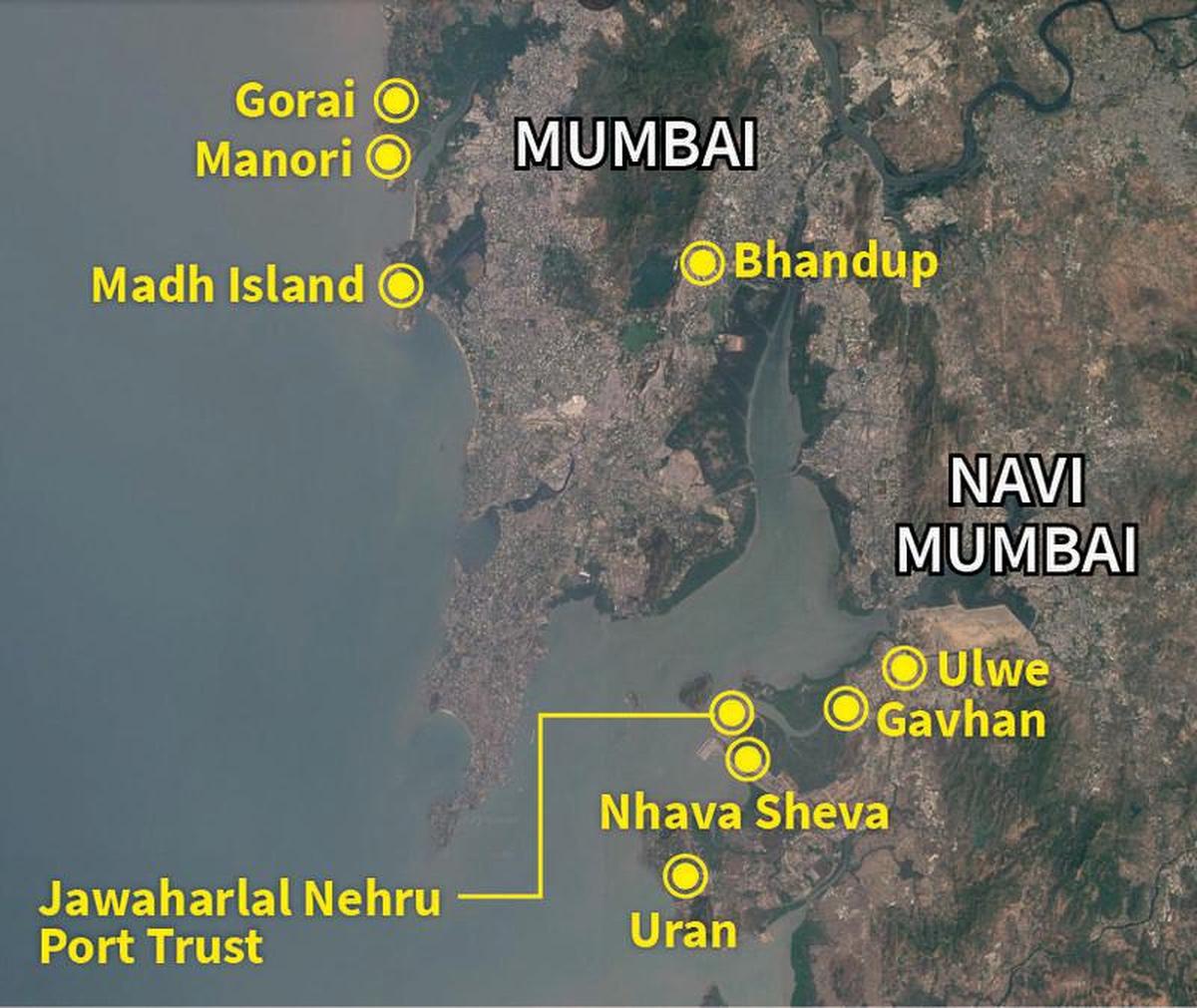SSignboards proclaiming ‘Mumbai Upgrading’ have become a ubiquitous sight at construction sites across the city and the Mumbai Metropolitan Region (MMR), heralding India’s financial capital’s ambitious drive towards world-class infrastructure.
However, for the city’s fishermen, this development comes at a cost. Hitesh Koli, a 35-year-old fisherman from Gawan village in Navi Mumbai’s Ulwe taluka, 35 km from Mumbai, laments, “We, the Kolis, are the original inhabitants of this area, yet no development project till now has given us priority. Has given.” Welfare.” Concern over dwindling fishing grounds and the destruction of mangroves to pave the way for infrastructure projects has sparked anger among members of his community.

Before the establishment of the Jawaharlal Nehru Port Trust (JNPT) 40 years ago, the Koliwada (fishing communities) in Gawan (9,000 inhabitants), Hanuman (4,500), Uran (6,000), Belpara (4,000), and Seva (5,000) fish. Could catch. Gawan, Uran, or Nhava within a 4 km radius of Sheva Creek. Now, they have to travel 27 km to Thane Creek. “JNPT initially destroyed mangroves and marine life, then came projects like Mumbai Trans Harbor Link (MTHL) and Navi Mumbai International Airport (NMIA). MTHL alone destroyed millions of mangroves, decimating marine life. In the last few years, we have lost 90% of our fishing spots due to such projects,” says Hitesh.
Generations of Koli and tribal people have lived on the coast of Mumbai, dependent on fishing for survival. For them, mangroves are sacred because they provide protection from natural disasters and resources for livelihood. Parvati Hadal, 32, a member of the Warli tribe, an indigenous community of about 6,000 people, exemplifies this heritage. All 12 members of her family in Madh Island are engaged in fishing.
In September, the Brihanmumbai Municipal Corporation (BMC) approved a ₹3,246-crore flyover connecting Madh Island and Versova and planned to pass over Madh Creek. This long-awaited project – first proposed in 2015 – received environmental clearance in January this year. Hadal expressed concern about the impact of the flyover on three villages: Kisanchapada, Dongarpada and Dharwali, whose residents depend on the mangroves for their livelihood. “Mangroves are being cleared daily for the construction of the flyover. Some parts of the project encroach on residential areas, threatening our homes and ancestral lands. Despite several letters to the BMC, our pleas fell on deaf ears,” she says.

A girl sits on an abandoned boat in Gorai, where mangroves have been rapidly harvested over the past 10 years and wetlands have been filled with debris. , Photo courtesy: Purnima Sah
Struggle of Uran Koliwada
Residents of Uran Koliwada are also bearing the brunt of development projects. On a calm afternoon in a fishing colony, Tukaram Janardhan Koli, 70, gazes intently at the mangrove creek outside his house. Once pristine, the waterway is now stagnant, reeking of chemicals and sewage. Plastic bags cling to the branches of the mangroves, swaying gently in the wind, a stark contrast to the lifeless water. Tukaram says that no government in Maharashtra has considered bringing development to fishing communities.
Recalling the fishermen’s struggles, he says that on February 7, 2023, the state-run City and Industrial Development Corporation (CIDCO) fined 30 residents under section 355 of the Indian Penal Code for raising concerns over the construction of Uran. falsely accused”. Bypass Road. He says the residents were detained for 12 days, with 10 women sent to Kalyan’s Adharwadi jail and 20 men sent to Taloja jail.
Following the intervention of lawyer Mihir Desai, the Bombay High Court ordered their release, citing concerns over alleged ill-treatment of the fishermen. The court also pulled up the police and CIDCO on the basis of the arrest and directed them not to file a chargesheet in the case even though the investigation can continue.
Earlier in August 2022, following a petition filed by 134 fishermen of Uran Koliwada, a division bench of the High Court, comprising Justice GS Patel and Justice Gauri Godse, had pulled up CIDCO over the project. The bench also criticized the government’s approach towards planning and said it appeared to be “prima facie flawed”.
The once prosperous Uran Gulf now smells of decay, its waters devoid of fish and filled with debris. Feeling helpless, the Kolis took to the streets again on July 7, 2023, against the impact of such projects on their livelihoods, but their pleas fell on deaf ears, says Tukaram.
‘Environmentally sensitive areas in danger’
Gorai and Manori villages face similar challenges, with destruction of mangroves and wetland reclamation over the past decade threatening the environment and livelihoods of East Indian Christians, Koli and tribal communities. Residents, including Swetsi Henriques, president of Gorai Villagers Welfare Association, have appealed to civic bodies and contacted the police. “Destroying mangroves and filling wetlands with debris happens late at night. Over the past few years many resorts and commercial spaces have emerged in eco-sensitive areas,” says Henriques. They allege that nearby amusement parks are dumping debris and garbage into the wetland. “When we lodged a complaint with the police, they instead accused us of indulging in such activities to extort money.”
Vanita Shankar Kottal, a 45-year-old fisherman from Chhota Dongri Pada in Gorai, expresses grave concerns about the future of her tribal village, where fishing is the primary source of livelihood. For seven months, she says, the civic body has been carrying out surveys without consulting residents, and has started constructing concrete roads towards Gorai Bay. He fears that under the cover of darkness the mangroves will be cut or the bay will be filled with debris. “We are living in fear. If this happens we will lose everything.”

Vanitha Shankar Kottal, a fisherman woman from Gorai, says the civic body is conducting surveys in the area without consulting residents. , Photo courtesy: Purnima Sah
Fishermen community unite
Nandkumar W., 63, environmentalist and president of Maharashtra Small-Scale Traditional Fish Workers Union. Pawar highlights the risks posed by NMIA. In 2005, after the fishing hub of Bhandup started losing its fishing habitats due to infrastructure projects, Pawar started working towards taking the concerns of environmental damage and the struggles of the fishing community to various global platforms. Did. “The association was formed to give voice to the small-scale fishermen who are often ignored by policy makers because they fish not in the sea, but in backwaters, creeks or water tanks,” he They say.
Pawar explains that the NMIA poses a significant threat to the coastal ecology due to its location in an ecologically sensitive area. “To reclaim the wetland, 10 to 12 feet of fill material is required in the natural low-lying areas here. It is estimated that about 26% (19,000 hectares) of the total area consists of ecologically sensitive areas. The project also includes 400 acres of mangrove land. The matter of concern is that more than a thousand acres of wetlands, which are home to at least five lakh migratory birds, will be destroyed forever.
Pawar also raised concerns over the diversion of Ulwe and Garhi rivers and leveling of Ulwe hill to make the NMIA site accessible. “This is nothing but an invitation to disaster by CIDCO and the government.”
He says siltation caused by continuous drilling and excavation work from coastal development projects such as ports, bridges and oil exploration is a major threat to coastal biodiversity. This process traps larger particles, creating mud that settles on the shore due to waves and tides, promoting unnatural mangrove growth. Pawar explains that this impacts fishing beds and breeding and spawning grounds as mangroves cover the water and leave no space for marine creatures to breed.
In 2021, a response to information sought by environmentalists under the Right to Information revealed that there are 913.6 hectares of mangroves in Nhava Sheva under the jurisdiction of JNPT. Earlier this year, JNPT acquired 800 hectares of land after Vanashakti, an NGO, filed a contempt petition against JNPT, CIDCO, revenue and forest departments, Maharashtra Coastal Zone Management Authority, Mumbai Metropolitan Region Development Authority and district collectors. Handed over to the Forest Department. Mumbai Suburban, Thane, Palghar, Raigarh, Ratnagiri and Sindhudurg. “For 20 years, none of these agencies complied with the orders. When we moved the high court in 2022, JNPT complied,” says Stalin Dayanand, director of Vanashakti.
Data submitted to the High Court in August this year by the Additional Principal Chief Conservator, Mangrove Cell, showed that around 248 hectares of mangroves were destroyed without permission from the NMIA. However, Chief Conservator of Forests, Mangrove Cell, SV Rama Rao, says, “CIDCO had taken permission from the Government of India and the Forest Department for diversion of 248 hectares of forest land, a part of which was mangrove land and the rest forest. land.”
The Panje-Dongri wetland in Uran has been a contentious issue, with Pawar and fishermen fighting to save this 289 hectare ecosystem. Recognized by the Bombay Natural History Society as one of the highly bio-diverse coastal wetlands in Maharashtra, it boasts rich traditional fishing areas and habitat for approximately five lakh migratory birds.
According to Pawar, CIDCO has designated the Panje-Dongri wetlands as flood mitigation areas for the upcoming Dronagiri node, spread over 2,740 hectares. It is one of the 14 nodes planned in Navi Mumbai to reduce pressure on Mumbai as part of a new city development project.
To protect and conserve these wetlands, Pawar filed a petition in the High Court in 2018. In 2021, another petition was filed in the National Green Tribunal and later a caveat was filed in the Supreme Court. On January 24 this year, the High Court ruled in favor of the petitioner and said that these pristine pieces of coastal wetlands should be preserved and protected. JNPT and CIDCO officials were not available for comment.

Plastic bags are stuck on the branches of mangroves in Uran taluka of Navi Mumbai. Photo courtesy: Purnima Sah.
Government response
In response, government officials cite the increase in mangrove cover in the state. According to a 2013 report by the Forest Survey of India (FSI), Maharashtra had 186 square kilometers of mangrove land. Eight years later, in 2021, the count reached 324 square kilometres, says Rama Rao. “There has been a significant increase in mangrove cover. 2023 FSI report has not been released yet.
According to the Chief Conservator of Forests, Mangrove Cell, the Mangrove Cell has initiated conservation measures such as issuing a tender in September this year to install CCTV cameras at 195 sensitive locations in the MMR to prevent garbage dumping and encroachment.
“We have maintained satellite data from 2005 to 2018 and are planning to purchase high-resolution satellite maps for better land analysis and to determine whether a particular area is mangrove land or not. Our Mangrove Security App allows citizens to lodge complaints about wrongdoings in mangrove areas and prompt action will be taken based on them. We have also deployed 184 security personnel and set up a three-tier committee at the district, divisional and state levels to monitor the mangrove areas,” he says.
To address violations in such areas, a two-pronged approach is being adopted, says Rama Rao. “Violations within the forest jurisdiction are addressed under the Indian Forest Act. Other violations fall under the Environment (Protection) Act and the respective district collectors have been tasked with taking action in such cases.
However, for the fishing communities in the city, the struggle for survival continues. “Who is Mumbai upgrading for?”. Hitesh, in Gawan village, says he is looking for development that prioritizes the well-being of the city’s original inhabitants.
published – October 18, 2024 02:22 am IST


